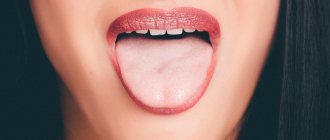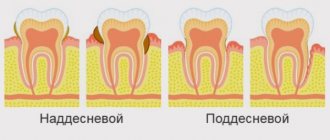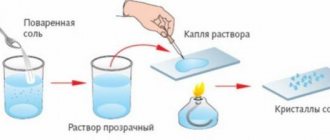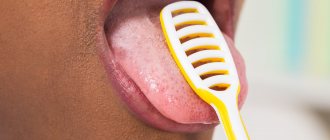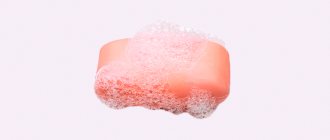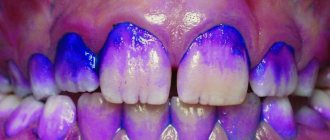A white tongue in a newborn after feeding is a common occurrence. These are milk residues; removing them from the surface will not be difficult. But the appearance of a thick, cheesy coating in the mouth, anxiety, and poor appetite in a child indicate more serious reasons and require the help of a pediatrician. The doctor will determine why the baby has a white coating on the tongue and will develop an effective treatment regimen.
How to properly clean your tongue
Dental experts recommend using tongue hygiene tools after brushing and antibacterial rinsing.
In the direction from root to tip, using “combing” movements, you should first clean one part of the tongue, and then the other. Then clean your tongue with crosswise movements to remove plaque from the depressions. Afterwards you need to rinse your mouth with water. For rinsing, you can use antiseptic rinses. But you shouldn't abuse them. It is better to consult a dentist. A specialist will help you choose the most suitable hygiene tool and determine the frequency of use of the rinse aid.
Is a regular brush suitable for cleaning?
Experts do not deny the effectiveness of using a traditional toothbrush as a tongue cleaning tool. You should choose a tool with soft bristles, apply a little toothpaste to it and gently clean the surface. You can choose devices with a textured surface made of plastic or rubber.
After cleaning your teeth, you need to turn the brush over and clean the organ using the movements described above. An electric and ultrasonic brush and irrigator are also suitable for cleaning the surface of the tongue.
When did people start cleaning their tongues?
Even in ancient times, people realized that it was necessary to clean their tongue. The Uzbek doctor Avicenna was one of the first to recommend cleaning the tongue in his treatise “The Canon of Medical Sciences”. He suggested using cypress cones as a device. The texture of the cone has a rough surface of medium hardness, therefore it is optimal for cleansing. Also, the cypress cone has bactericidal properties; its resin has a disinfecting effect on the oral cavity.
Representatives of Ancient China chose silver scrapers as a hygiene device. This technique was also used in the territory of Ancient Rus'. People from the upper classes believed that cleansing the organ allows not only to care for it, but also to enhance the sense of taste. The instruments were used before meals to stimulate the taste buds.
So what should you choose?
Cypress cones and silver scrapers have been replaced by irrigators, ultrasonic brushes and other modern means. To choose the most suitable one for yourself, consult with a specialist - he will take into account the condition of your oral cavity and help you make the right choice.
Did our ancestors clean their tongues?
People began using tongue cleaning devices at least five centuries ago. An example of this is the mention of the need to cleanse this organ of our body in the treatises of the 10th century AD. Uzbek doctor Avicenna. For the most effective procedure, he recommended using cypress cones and tree slivers, which are rich in essential oils. In ancient China, members of the nobility used a tongue scraper to clean their tongues before each meal, as it was believed that thanks to this procedure they could fully appreciate the taste of the dishes. Residents of our country made special scrapers from silver, which disinfected the oral cavity and prevented various inflammations such as mouth ulcers, candidal stomatitis, various types of glossitis, etc.
Cleaning the tongue. Other methods
We usually hear or read the phrase “imbalance of microflora” or “dysbacteriosis” in relation to the condition of the intestines. In fact, both beneficial and harmful microorganisms also exist in the oral cavity.
And, of course, their correct ratio is very important: if the number of harmful microorganisms for some reason predominates, this leads to increased plaque formation, including on the tongue
If the balance of oral microflora is disturbed, you should be more careful about hygiene. There are also methods aimed at suppressing harmful microorganisms in the mouth, which are good to perform in parallel with brushing the tongue in the mornings and evenings.
Types of plaque in infants
As a rule, thrush manifests itself in newborns and infants as a coating on the tongue. There are three types of shades: yellowish, gray and white.
- Yellow or gray color. This is a signal of infection in the body. It is possible that symptoms of a disease other than oral candidiasis may overlap. In this case, you should immediately seek advice from your pediatrician and do not try to solve the problem yourself. To exclude other pathologies, you will need to undergo tests, after which a specialist will prescribe treatment.
- White color. If a white, cheesy coating is detected in the baby's mouth, parents will need to observe him for some time. If it turns out that the baby often moves its tongue, as if trying to scratch it, this is a sign of ordinary thrush. To finally confirm the diagnosis, you need to consult a doctor.
Oral hygiene
It is necessary to brush your teeth at least twice a day - children absorb this almost with their mother’s milk.
It is important to form this habit at as early an age as possible. Ideally, it is necessary to start immediately after the appearance of the first teeth, so that the baby gradually gets used to the procedure
Every mother chooses an age-appropriate brush and toothpaste for her child, but not everyone is interested in how correctly they carry out hygiene measures.
Firstly, you should not brush your teeth by moving the bristles along the jaw, as this will thin out the enamel faster.
Secondly, it is necessary to pay careful attention not only to the front, but also to the back, as well as the chewing surface, on which plaque may also accumulate or food particles may remain, because the goal is to maintain health, not beauty, and the second is impossible without the first
Another common mistake is completely ignoring the rest of the mouth. Cleaning the tongue and the inner surface of the cheeks, as well as massage of the gums, as a rule, are not carried out at all or occur only from time to time
This is wrong; you need to constantly pay attention to these parts, because the health of your teeth also depends on their environment. And careful attention to the rest of the mouth can prevent a large number of extremely unpleasant diseases, so do not neglect it
Prevention of thrush in an infant
To prevent the development of candidiasis in your baby, mothers should take preventive measures:
- Use individual children's dishes.
- Treat nipples, bottles, and rodents with boiling water.
- Rinse your breasts with soda solution before each feeding (if the baby is on breastfeeding).
- Make sure that the mucous membrane in the child’s mouth does not dry out, for example, from long and prolonged crying.
- Maintain recommended humidity levels in the nursery. Make sure it is fresh and light.
- Give a few drops of boiled water several times a day in between feedings. This will help wash away any remaining milk or baby food, which is a good prevention of candidiasis.
- Under no circumstances should you treat your child with antibiotics without consulting a pediatrician.
- Maintain good personal hygiene to avoid becoming a carrier of thrush.
- Take care of the condition of your own nipples. In case of peeling, redness and itching, consult a doctor immediately and take measures for a speedy recovery. Otherwise, the fungus will move to the baby. In this case, comprehensive treatment of mother and baby will be required.
How to clean plaque from your tongue and restore it to a healthy appearance?
Ideally, a small white coating is always present on the tongue of a healthy person. This is normal and should not cause concern. But what to do if the layer of this plaque becomes significant, it changes its color to yellow, black and even green, and your breath begins to smell bad? The cause of this phenomenon should be sought as soon as possible and measures taken to remove such deposits.
White plaque may indicate some kind of infection and digestive problems.
It can turn yellow due to a malfunction of the liver and gall bladder, but black and green plaque color is rare and in the first case signals an increase in blood acidity, Crohn's disease, cholera and others, and in the second we can talk about yeast, mycotic or candidal glossitis.
Changes in the structure, color and volume of plaque at different times can be observed by heavy smokers and alcohol abusers. In any case, yellow plaque, like any other, requires combating this problem, and it should be started only after the cause has been determined.
How can you clean your tongue from plaque? First of all, it is necessary to maintain oral hygiene by regularly brushing your teeth twice a day. Today on sale there are special brushes with a ribbed base that allow you to clean your tongue.
If you cannot find such a brush, you can use a regular spoon, cleaning the surface with its edge. Experts advise resorting to the help of traditional medicine. A decoction of sage, chamomile and oak bark has a good effect. It is used to rinse the mouth after every meal.
Beekeeping products, known for their medicinal properties, can also come to the rescue. So, an alcohol solution of propolis can be used for rinsing, and if there is a pure product, it is recommended to chew its pieces for several minutes 3-4 times a day. How else can you clean your tongue from plaque? Regular gauze or cotton cloth.
Just wrap your index finger in a piece and walk over the surface of the plaque-covered organ. In ancient India, it was customary to solve this problem with the help of oil. You can use this method too.
It is enough to hold a spoonful of oil in your mouth for 7-10 minutes, shaking occasionally, to get rid of harmful waste in the oral cavity.
How can you clean a newborn’s tongue of plaque? In babies, a white coating on the tongue is a common occurrence, because in the first year of life, the basis of their diet is mother's milk or formula. But it often happens that the child’s gums, palate and cheeks become covered with plaque.
In this case, the doctor prescribes special treatment and recommends cleaning, but how to do this? There is no need to be scared, there is nothing complicated about it and, having calmed down enough, you can completely cope with the doctor’s task on your own.
Here are some ways to clean your baby's mouth:
- Prepare a swab from a bandage and, moistening it in a solution of baking soda, treat the oral cavity. A solution of soda can be replaced with borax in glycerin;
- How can you clean your child’s tongue from plaque? Buy pink vitamin B12. Moisten the bandage with the solution and let the baby suck. You can simply inject a portion of the vitamin into your mouth with a syringe without a needle;
- You can blot the surface of the tongue and oral mucosa with the same bandage swab dipped in an aqueous solution of myrrh and ratania. You need to buy these two tinctures at the pharmacy, mix them in equal parts and dilute them with water in a ratio of 1:2;
- The uvula and mucous membrane can be wiped for a newborn baby with a swab dipped in an oil solution of “Chlorophyllipt”. If your baby has thrush, it is recommended to treat the oral cavity with a mixture of vitamin B12 and one crushed Nystatin tablet.
In the future, it is necessary to more carefully monitor hygiene and prevent dirt and bacteria from getting into the baby’s mouth from a pacifier that has fallen on the floor, unsterilized bottles, unwashed toys, etc. For adults, it is also better to prevent the occurrence of this unpleasant problem than to treat it.
Therefore, if you brush your teeth, floss regularly and rinse your mouth with special solutions, then harmful waste in the oral cavity is unlikely to occur. Be healthy!
Causes of thrush in babies
Reference. The human body constantly contains many bacteria, including the opportunistic microorganisms Candida (microscopic yeast-like fungi). Weakened immunity contributes to the development of fungus in the body and its appearance on the mucous membranes, in particular in the oral cavity. A characteristic symptom is a white coating on the tongue.
Causes of thrush in babies:
- the presence of fungus in the mother and its subsequent entry into the child’s body;
- weakened immunity due to illness or stress, taking antibiotics;
- drying out of the oral mucosa due to frequent screams, insufficient room humidity, and nasal congestion;
- pacifier licking by infected adults.
Treatment of thrush in women with soda.
Which hygiene product is better?
The list of devices for oral care is huge. In the first place are special scrapers for cleaning the tongue. They are made of plastic and resemble a tool with a long handle and a spoon tip. It is recommended to change products at the same frequency as a toothbrush.
Scraper brush
The device is characterized by a combination of scraper and brush and has very delicate bristles. The shape is flat, which helps prevent the occurrence of a gag reflex during the process of cleansing the tongue.
You can often purchase products with convex rubberized or plastic embossed strips, which promote better hygiene.
Spoon
A tongue cleaner is another great tool. Presented in the form of an elastic nozzle ending with a spoon. The water that flows through the instrument allows for manipulations to be performed quite efficiently and gently. Very often, such spoons are used as attachments for electric brushes, as well as irrigators.
Toothbrush
Many people often use regular toothbrushes with toothpaste. In such a situation, it is better to choose products with soft or medium-hard bristles. In addition, you can purchase a special brush with a textured surface on the back side. Upon completion of hygienic procedures with teeth, the device is turned over and movements are made in the direction from the root of the tongue to its tip.
You can clean the surface with your usual toothbrushes, as well as with ultrasonic, electric or irrigators. Owners of the latest devices only need to purchase a tongue attachment.
Types of scrapers
Manufacturers offer several types of devices for removing deposits:
- scrapers;
- brushes;
- spoon-shaped irrigator attachments;
- scrapers-brushes.
All models differ in external shape, quality and characteristics of the material, and purpose.
Why can't you use a regular toothbrush for this procedure? You can clean the mucous membrane with a simple teaspoon and a toothbrush. But this should be a temporary measure, since with constant use of these items you can accidentally injure the delicate surface of the mucous membrane.
Brushes
How to choose the right brush for removing plaque? You should pay attention to the material of the product, the shape and stiffness of the bristles. Dentists do not recommend using brushes with hard bristles, as they injure the mucous membrane and contribute to the development of inflammation.
It is advisable to choose a brush with soft bristles that delicately remove plaque and deposits.
Basically, brushes are made of special plastic, but there are products made of silver or with the addition of silver. Salivary fluid activates the antibacterial properties of this metal.
The shape of the brush also matters for ease of use. It is advisable to choose a product with a long handle, which will allow you to clean the root of your tongue without strain. The shape of the brush and handle should be as adapted as possible to the shape of the tongue.
What hygiene product should I use to remove plaque using a brush? It is better to use special antibacterial agents in the form of gels to achieve maximum effect. Special ingredients included in the gel formula will keep your breath fresh and your mouth feeling pleasant for longer.
Scrapers
These devices resemble a spatula in shape and are preferred by people with a strong gag reflex. The product is designed so that its touch does not irritate the surface of the tongue and does not provoke gagging. When choosing a scraper you should consider:
- product material;
- the shape of the handle and blade;
- ergonomics.
The material matters, as manufacturers make products from copper, plastic or silver. Silver models will additionally disinfect the oral cavity, destroying pathogenic microflora. Copper models will last a long time, compared to plastic ones, which must be replaced every two weeks. But metal scrapers require cleaning with boiling water, do not forget about this.
The scraper blades should be easily washed under the pressure of a stream of water.
This is very important as they should be rinsed after each cleaning stroke. The shape of the blade and handle should be ergonomic
The handle should not slip in the hand, and the blades of the paddle should conform to the shape of the tongue.
A tongue scraper with two blades removes deposits much faster than models with one. Manufacturers claim that the machine with two blades prevents the induction of vomit. This type not only copes with its task more effectively, but also reduces the time of hygienic manipulations.
It is also worth paying attention to innovations: manufacturers offer a combined product that combines the functions of a brush and a scraper. This model, with its rounded shape, resembles a spoon, but has bristles on it
With the help of such a device you can remove the densest sediment.
Irrigator attachments
An irrigator is a device for cleaning teeth with a stream of water under pressure. This is a soft and gentle, but very effective oral care product. A stream of water penetrates into the most inaccessible corners of the oral cavity, freeing them from the accumulation of food particles and bacterial deposits.
To remove plaque using an irrigator, a special spoon has been created that helps care for the surface of the tongue. The spoon does not cause gagging and efficiently removes deposits from all sides. Use the spoon attachment immediately after brushing your teeth. You should first carefully read the instructions, as some models are equipped with additional functions.
How and when to start cleaning your child's tongue
How to clean a baby’s tongue, and whether this is necessary, is a question that concerns many conscious parents. Of course, there are no indications for this procedure for a newborn, but with the appearance of the first tooth, it’s time to start.
Today the most popular brands are ROCS, Chicco and Splat. The surface of the brushes is made of silicone bristles or has a ribbed appearance. There is not much difference between them, the products work equally effectively, it all depends on the preferences of the parents and the baby.
To properly clean a newborn’s tongue, a finger toothbrush is placed on the finger. The movements should be smooth, as if “sweeping”, moving in the direction from the root of the tongue to the tip.
After performing several movements according to this principle, you can begin to cleanse the lateral surfaces of the organ. Then move to the inside of your cheeks, and after that be sure to rinse your mouth.
Until your child is able to rinse his mouth on his own, it is not recommended to use any toothpaste!
As a rule, it takes no more than three minutes to clean your tongue. Irregular and poor oral hygiene provokes the development of pathogenic flora, which, in turn, can lead, for example, to caries, glossitis or stomatitis. It turns out that in a matter of minutes you can remove bad breath and prevent the development of many diseases.
Everyone knows that preventative measures are always more pleasant and less expensive than treatment. Therefore, it is better to acquire a new useful habit - brushing your tongue every time after teeth.
How to clean your tongue?
To cleanse the child's tongue of white plaque, parents can use a soda solution.
This is an affordable and budget-friendly product that can be easily prepared at home.
The procedure is carried out in several stages:
- Dissolve one teaspoon of baking soda in a glass of warm filtered water.
- Wash your hands thoroughly with soap and prepare a small piece of sterile bandage.
- Wrap a bandage around your finger and dip it in a glass of medicinal solution, thoroughly saturating the fabric.
- Gently wipe your baby's tongue, inner cheeks and palate, removing all plaque. There is no need to apply force or pressure; just walk over the affected areas with light movements so as not to cause discomfort to the child.
- Repeat the procedure 5-6 times a day until the oral cavity is completely clean.
Important information! Baking soda has bactericidal properties and neutralizes the effects of inflammation in the oral cavity.
However, self-cleaning of the tongue with soda solution can only be done after consultation with the pediatrician . You also need to make sure that the child does not have allergies.
Is it necessary to clean your tongue of plaque and why do it?
The tongue should be cleaned of plaque every day during morning hygiene procedures. Regular and high-quality cleaning of the taste organ:
- reduces the concentration of pathogenic bacteria in the oral cavity;
- is an excellent prevention of infectious diseases;
- prevents the development of digestive problems;
- helps protect tooth enamel and prevents caries;
- eliminates unpleasant odor from the mouth;
- improves taste perception.
Tongue of a healthy person
The tongue of a healthy person is pink. It should be elastic, moist, without wounds, cracks and swelling. Even with ideal health, a thin layer of white or gray plaque periodically forms in the mouth, which can be easily removed by carrying out simple hygiene procedures.
But the plaque can be different: one can be removed on your own, while the other can only be removed after long-term treatment under medical supervision. Plaque on the tongue is a kind of indicator of a person’s health status, therefore, if there are any changes in its color or structure, you should consult a doctor to identify and treat the disease that triggered the development of such signs.
Reasons for appearance
A white coating on a baby's tongue often appears as a result of breastfeeding.
However, the occurrence of this symptom can also be caused by various diseases and non-pathological factors . Among them:
- Candidiasis or thrush . It occurs when the bactericidal properties of saliva are lost and is diagnosed when active activity of yeast-like fungi is detected. The pathological process develops as a result of insufficient oral hygiene and without proper treatment can lead to damage to the larynx and internal organs.
- Disruption of the gastrointestinal tract . In the first months of life, the child’s gastrointestinal tract is not sufficiently formed. Because of this, the intestinal microflora can be disrupted due to poor nutrition. Babies who are bottle-fed or mixed-fed are especially susceptible to the problem.
- Gastritis with high acidity. The disease is extremely rarely diagnosed in infants and becomes one of the reasons for the appearance of white plaque. Acidity disorders in early childhood are associated with parasitic lesions of the gastrointestinal tract or congenital amino acid deficiency. This negatively affects the child's well-being.
- Viral stomatitis. Inflammatory infectious disease of the soft tissues of the oral cavity. It is characterized by a deterioration in the child’s general well-being, the appearance of mouth ulcers and an increase in body temperature. The occurrence of stomatitis is caused by acute and chronic diseases that can weaken the baby’s immunity.
- Allergic reaction. Appears as a result of long-term use of certain medications, consumption of infant formula, or contact with an allergen.
- Decreased hemoglobin levels in the blood. The problem is related to iron deficiency and often leads to oxygen starvation because cells and tissues do not receive enough oxygen. In this case, the blood circulation process is disrupted, and the microelements necessary for the body are poorly absorbed.
Keep in mind! Plaque that appears on a baby after feeding or regurgitation is not a sign of the development of a serious disease.
Rinse your mouth with hydrogen peroxide solution
After breakfast, I recommend rinsing your mouth with a solution of water and hydrogen peroxide. You need to buy a peroxide solution at the pharmacy, it costs a penny, but it has a lot of benefits!
Rinse solution: 10 drops of 3% peroxide solution per 50 mg of clean, unboiled water. There is no need to increase the proportion of peroxide; you can “burn” the mucous membrane.
What does this give?
1. Prevention of dental and gum diseases. Those who regularly rinse with peroxide go to the dentist mainly only for preventive examinations.
2. After regular antiseptic treatment of the oral cavity, “bad” odor from the mouth is eliminated.
3. Teeth gradually whiten.
These are the simple morning procedures, tested from our own experience. In general, my set of morning procedures is much longer and lasts more than an hour. In addition to the simple recipes listed in the post, there are also acupressure massage, contrast showers, joint gymnastics, the Vietnamese Ziongshin yoga complex, the Baitap Khi breathing complex, special exercises for the spine, the Wing Chun martial practice complex, and meditation. After all this, you get an excellent charge for the whole day. Gradually, in other articles I will tell you about the other listed practices.
Thank you for your attention!
Sergey Borodin, 2013
This and other topics are covered in more detail in my books in the “Phoenix Code” series. Technologies for changing life." LOOK.
Benefits of Cleaning Your Tongue Regularly
Hygiene of the surface of the tongue is not a tribute to fashion and not just another invention of manufacturers of oral care products
Special attention has been paid to this for a long time. The tongue scraper was made from turtle shell or ivory
Later they began to be cast from silver. The medieval physician Avicenna wrote about the benefits of hygienic tongue care in his treatises. In the time of Avicenna, split sticks of wood rich in essential oils or small cypress cones were used for hygiene.
In India, the benefits of mucosal hygiene were also correctly assessed. Yogis used wooden spoons or cleaned the mucous membranes with three fingers wrapped in cotton.
Regular tongue care helps:
- strengthening the immune system;
- normalization of taste perception of food;
- prevention of bad breath.
How does oral hygiene improve the immune response? Toxic substances—bacterial waste—accumulate in the white coating. Unremoved toxic substances are absorbed into the blood over time, forcing the immune system to fight their harmful effects. Accordingly, removing toxins does not burden the immune system, which helps strengthen it.
Taste buds are located throughout the surface of the tongue, it is thanks to them that a person feels and recognizes taste. Bacterial sediment on the surface clogs the taste buds, reducing the pleasure of eating food. Freeing the taste buds will restore the correct perception of foods.
Most bacteria are found on the root of the tongue. Thanks to the convenient shape of the sediment scraper, you can get rid of many pathological microorganisms and achieve fresh breath. In addition to eliminating deposits, the cleansing brush has a gentle massaging effect, promoting high-quality blood circulation in the oral cavity.
The tongue can be used to diagnose diseases, so its cleanliness will indicate a healthy body. Regular cleansing will bring not only aesthetic benefits, but will also promote health and allow you to recognize the onset of diseases of the internal organs. If a lot of deposits have accumulated on the mucous membrane, this indicates a serious internal disease.
Types of plaque and disease
- A thin white coating indicates a decrease in the body’s protective functions;
- a coating of cheesy consistency signals the development of a fungal infection in the oral cavity;
- mucous membrane in cracks warns of the development of gastritis;
- a gray tint of deposits indicates a severe complication of the existing disease;
- a yellow tint of deposits indicates problems with the gastrointestinal tract and liver;
- a green tint indicates problems with the liver, which is not able to cope with its functions;
- a brown tint occurs in alcohol-dependent people or in cases of problems in the gastrointestinal tract;
- a black tint occurs in heavy smokers or in people with serious disorders of the liver and gastrointestinal tract.
The advantage of regular use of a scraper is precisely the timely diagnosis of the onset of diseases.
Why does plaque appear on the tongue and its signs?
There is plaque even on the tongue of a completely healthy person. It appears because particles of consumed food are retained between the taste villi and lingual papillae, causing the active proliferation of bacteria. Over time, bacteria die due to the work of the immune system, but they do not disappear without a trace - food particles, saliva, keratinized epithelial cells, dead microorganisms and their metabolic products settle on the tongue and form plaque.
During eating and thanks to salivation, plaque almost completely disappears from the surface of the tongue. However, most often the basal region and the root of the tongue remain covered with a thin film, through which the lingual papillae can be easily seen. This residue is also littered with germs that can trigger the development of numerous dental diseases - which is why you need to regularly remove it when brushing your teeth.
Signs of plaque on the tongue are within normal limits
Even in the absence of supporting symptoms, coating on the tongue may indicate health problems. But you shouldn’t run to the doctor immediately after discovering this unaesthetic film. Sometimes it is normal, in this case you just need to regularly clean your tongue and remove the plaque that forms on it. But if there are pathological signs, it is necessary to visit a doctor as soon as possible and undergo a diagnosis.
Plaque occurred due to natural physiological reasons if it:
- whitish or yellowish;
- homogeneous;
- does not cause pain;
- covers the root and basal region of the tongue with a thin layer, and the lingual papillae are visible through it;
- easy to remove with regular hygiene;
- appears after eating food, in the morning, due to thirst;
- has no unpleasant odor;
- not accompanied by other symptoms.
Signs of pathological plaque on the tongue
A coating covering the tongue may indicate that the body is experiencing certain problems. In such cases it becomes:
- thicker and denser;
- not amenable to removal;
- yellow, gray, brown, green, red or even black;
- covering the entire tongue or its lateral parts;
- smelling bad;
- accompanied by a bitter taste in the mouth.
What diseases may a coating on the tongue indicate?
It is impossible to determine the cause of plaque formation at home; for a reliable diagnosis and prescribing the correct course of treatment, you should consult a doctor. But you can guess what diseases could lead to the manifestation of such symptoms on your own.
Candidal glossitis (thrush)
Yellow, yellowish-gray and white plaque may indicate the following pathologies:
- disruptions in the digestive system, inflammatory processes, dysbacteriosis;
- gastritis, stomach ulcer;
- impaired intestinal motility, flatulence, problems with bowel movements;
- liver damage;
- inflammation of the oral mucosa (glossitis);
- diseases of the gums, teeth, palate;
- disturbances in the functioning of the endocrine or hormonal system;
- poisoning, malnutrition, mild dehydration;
- the presence of worms;
- malignant and benign formations.
A greenish coating may indicate fungal diseases and long-term drug therapy. Brown is a constant companion of people who abuse smoking, drinking alcohol and eating heavy food. In addition, it may indicate diseases of the upper and lower respiratory tract.
Villous glossitis
Black plaque is rare and usually accompanies serious diseases such as:
- Crohn's disease;
- severe dehydration of the body;
- increase in blood acidity;
- villous glossitis;
- pancreatitis or cholecystitis.
It should be taken into account that consuming products containing strong dyes also affects the color change of plaque in the mouth. If it turns yellow or blue-green immediately after eating a candy of a similar color, then there is no need to look for another reason for this phenomenon.
Signs of plaque on the tongue
Tongue plaque can be a physiological phenomenon or a side symptom of a serious disease. In the first case, you can remove the white coating on the tongue yourself, without going to the dentist. In the second, you will need the help of a qualified specialist. A white tongue can directly indicate a fungal infection or dehydration of the body
Physiological signs:
- Uniform white or yellowish color;
- A thin layer through which the lingual papillae are clearly visible;
- No unpleasant odor, pain, or other symptoms;
- Appears for certain reasons, for example, due to thirst;
- Easy to clean with a toothbrush.
Pathological signs:
- Dense consistency, difficult to remove;
- Unhealthy color: yellow, brown, gray;
- Covers the entire surface of the tongue;
- Accompanied by an unpleasant odor;
- A sour or bitter taste appears in the mouth.
Which hygiene product is better?
The list of devices for oral care is huge. In the first place are special scrapers for cleaning the tongue. They are made of plastic and resemble a tool with a long handle and a spoon tip. It is recommended to change products at the same frequency as a toothbrush.
Scraper brush
The device is characterized by a combination of scraper and brush and has very delicate bristles. The shape is flat, which helps prevent the occurrence of a gag reflex during the process of cleansing the tongue.
You can often purchase products with convex rubberized or plastic embossed strips, which promote better hygiene.
Spoon
A tongue cleaner is another great tool. Presented in the form of an elastic nozzle ending with a spoon. The water that flows through the instrument allows for manipulations to be performed quite efficiently and gently. Very often, such spoons are used as attachments for electric brushes, as well as irrigators.
In addition, you can learn from people’s experience of how to clean your tongue from plaque with a silver spoon. It’s interesting that, for example, yogis use a wooden spoon for this.
But here it is important that the device is used only for these purposes
Toothbrush
Many people often use regular toothbrushes with toothpaste. In such a situation, it is better to choose products with soft or medium-hard bristles. In addition, you can purchase a special brush with a textured surface on the back side. Upon completion of hygienic procedures with teeth, the device is turned over and movements are made in the direction from the root of the tongue to its tip.
You can clean the surface with your usual toothbrushes, as well as with ultrasonic, electric or irrigators. Owners of the latest devices only need to purchase a tongue attachment.
Plaque on the tongue. What to do
If you notice a thick layer of plaque on your tongue or a change in its color, then do not immediately panic.
Firstly, we need to analyze what we ate before, since the color of the tongue is often influenced by dyes in the composition of some food products, for example, in candies, caramels (especially lollipops and all kinds of candies - sweets from advertising) or the products themselves , this could include blueberries or coffee. After cleaning your mouth, this plaque should disappear.
Secondly, it is necessary to analyze the reasons causing increased plaque formation on the tongue.
Thirdly, you need to note how many hours after the morning cleaning of the oral cavity plaque appeared. If more than 3 hours later, then this is normal. It is also considered normal if the coating on the tongue normalizes after 5-7 days.
If plaque still bothers you, then first of all you need to be more careful about oral hygiene and carry out hygiene procedures twice a day.
The next step is a balanced diet, since a thick layer of plaque on the tongue can form after eating certain types of food, for example, after fatty, smoked, fried foods. Change your diet, giving preference to cooked foods, as well as fresh vegetables and fruits.
For these purposes, you can also use pharmaceutical preparations. Often a thick layer of plaque on the tongue occurs due to stagnation of bile in the gallbladder. Allohol tablets are a choleretic agent of natural origin. You can consult a doctor; usually the doctor prescribes a course of treatment from 2 to 4 weeks, two tablets three times a day before meals.
An important point for getting rid of plaque on the tongue is to normalize stool and get rid of constipation.
If these steps do not help and plaque still appears, you should definitely consult a doctor and undergo a full examination. When the disease leading to the formation of plaque is eliminated, the plaque will disappear on its own.
Prevention of plaque formation on the tongue
- Brush your teeth and tongue at least twice a day;
- Include fermented milk products in your daily diet, eat more vegetables and fruits;
- Reduce the amount of spices, spicy and smoked foods you consume;
- Quit smoking and alcoholic beverages;
- Regularly undergo preventive examinations at the dentist;
- Do not cause diseases of the gastrointestinal tract.
Do I need to clean my tongue of plaque? Of course, even if we are talking about the physiological characteristics of the body. The film that appears on the tongue is traces of the vital activity of pathogenic bacteria, so if the plaque is left unattended, a favorable environment is created for the development of infectious diseases of the oral cavity.
Thanks to irrigators and other devices, taking care of your oral cavity is not at all difficult, and by spending just a few minutes a day, you can maintain a snow-white smile for many years.
Author of the article

